|
|
|
Sort Order |
|
|
|
Items / Page
|
|
|
|
|
|
|
| Srl | Item |
| 1 |
ID:
160466
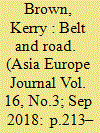

|
|
|
|
|
| Summary/Abstract |
We live in the era of storytelling and of leaders who are storytellers. That has always been the case. Max Weber argued that politicians are divided into sorcerers or warlords. With US President Trump, French President Macron, Russian President Putin, and above all with Chinese President Xi Jinping, we have people who might have access to plenty of assets of hard power, but who, aware of the cataclysmic risk of even appearing to deploy these, try to achieve their means by the magic power of stories.
|
|
|
|
|
|
|
|
|
|
|
|
|
|
|
|
| 2 |
ID:
166286
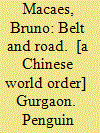

|
|
|
|
|
| Publication |
Gurgaon, Penguin Random House India Pvt. Ltd., 2019.
|
| Description |
xii, 227p.hbk
|
| Standard Number |
9780670092307
|
|
|
|
|
|
|
|
|
|
|
|
Copies: C:1/I:0,R:0,Q:0
Circulation
| Accession# | Call# | Current Location | Status | Policy | Location |
| 059652 | 337.5105/MAC 059652 | Main | On Shelf | General | |
|
|
|
|
| 3 |
ID:
178212
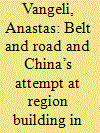

|
|
|
|
|
| Summary/Abstract |
This article analyses China’s Belt and Road as a medium through which novel regional development ideas and practices are being generated, (re)articulated, and diffused, via a case study of its implementation in the broader region of Central-East and Southeast Europe (CESEE). The example of CESEE shows that via the Belt and Road, Chinese actors have advanced comprehensive region work based on social interactions, which includes regular high-level diplomatic exchange and quasi-institutionalisation as well as people-to-people relations, resting on the potent geoeconomic imaginaries of the New Silk Roads. This approach, in the case of CESEE, has allowed for regional co-operation to advance even in times of friction and uncertainties. Nevertheless, as region work is essentially a contentious endeavour, China’s attempt at regionalism in CESEE has been challenged by the European Union (EU), the United States and regional actors who feel uneasy about China’s advance.
|
|
|
|
|
|
|
|
|
|
|
|
|
|
|
|
| 4 |
ID:
182693


|
|
|
|
|
| Summary/Abstract |
Although infrastructures may be material manifestations of state territorial power, the political effects of infrastructures are seldom straightforward. And yet, many accounts of the Belt and Road Initiative (BRI) assume a relatively conventional approach to politics, and to political power. Geopolitical intentionality and top-down policy and strategic planning tend to be emphasised over project-level analyses. In response to what might be viewed as an invented BRI geopolitics, this essay suggests a more technopolitical framing of the Belt and Road and seeks to apply an infrastructural analytic to the question of how political power is realised or frustrated, enhanced or diverted, by the distributed and relational nature of infrastructure projects. It argues that our understanding of the socio-technical complexities of infrastructure is poorly served by viewing them through a conventional geopolitical lens. Instead, it seeks to lay out a research agenda and analytical framework for addressing the questions of how infrastructure projects grow and evolve, how they are embedded within the social-political-cultural contexts in which they develop and how they produce political effects that at times align with broader-scale geopolitical agendas and at other times do not.
|
|
|
|
|
|
|
|
|
|
|
|
|
|
|
|
| 5 |
ID:
155247
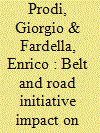

|
|
|
|
|
| Summary/Abstract |
This paper analyzes the impact of the Belt and Road Initiative on Europe with a specific focus on Italy. We concentrate on the impact of new railways and port infrastructures on bilateral trade. Our analysis suggests that the development of new railway connections will benefit most of the Northern and Central European countries. Some industries like automotive and electronics that have a higher value to weight ratio will benefit more than others. However, due to higher costs, railway services will never reach a high percentage of total import/export flows. Investment in new port facilities, although less “new” compared with railways, may be a bigger game changer. The development of the Port of Piraeus has already increased the importance of the Mediterranean Sea as an import/export hub for China. If the other planned investments in Egypt and Algeria are completed, this phenomenon will be magnified. This presents a huge challenge for Italy. The Italian port in the high Adriatic Sea could be displaced by Piraeus capacity, especially if this port is linked through railways with the center of Europe. Italy needs to coordinate its ports together with its railway network to take advantage of Belt and Road Initiative opportunities.
|
|
|
|
|
|
|
|
|
|
|
|
|
|
|
|
| 6 |
ID:
160005
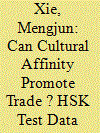

|
|
|
|
|
| Summary/Abstract |
As Chinese culture is “going out,” more and more non‐native Chinese speakers are beginning to study Mandarin and are taking the Hanyu Shuiping Kaoshi (HSK) test. Mandarin has become a very important trade language for the Belt and Road countries. This paper uses the difference‐in‐difference model and the Mahalanobis distance and the nearest neighbor distance matching methods to study the internal relationship between culture “going out” and foreign trade. We find that cultural affinity is an important factor in promoting trade, and that the HSK project has expanded China's exports to the Belt and Road countries. Culture's promotion effect in Asia is stronger than that in Europe. Culture's promotion effect shows the characteristics of regional differences, a time‐lag and a fluctuating upward trend. Therefore, further enhancing the international influence of its culture would help China to find a new source of export growth.
|
|
|
|
|
|
|
|
|
|
|
|
|
|
|
|
| 7 |
ID:
165729
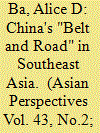

|
|
|
|
|
| Summary/Abstract |
China's Belt and Road Initiative (BRI) is viewed by most as symbolic of a new era of Chinese initiative and ambition. But while much attention has focused on how the BRI fits into China's—and specifically Xi Jinping's—grand narrative of national rejuvenation, less has been said about regional narratives—that is, the narratives of China's target audiences. Toward addressing this oversight, I consider the case of Singapore in relation to BRI. Specifically, I give attention to strategic narratives that offer analytic windows into the complex relationships being negotiated between China and Southeast Asian states. Strategic narratives, as instruments of policy, also play roles in constructing the strategic space in which BRI enters, with implications for the opportunities and constraints faced by China in Southeast Asia.
|
|
|
|
|
|
|
|
|
|
|
|
|
|
|
|
| 8 |
ID:
161513
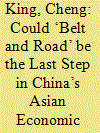

|
|
|
|
|
| Summary/Abstract |
This article assesses the role of China’s ‘Belt and Road’ initiative (BRI) in the country’s intended global economic integration. Particular attention is paid to China’s capital penetration of Asian markets, with an empirical assessment of the structure of Asian markets from the perspective of foreign trade, foreign direct investment (FDI) and intergovernmental aid. The success of China’s new opening-up initiative will be largely contingent on Asian markets’ recognition of Chinese products and capital: its trade with potential cooperative countries and its FDI and intergovernmental aid to them fall behind those of the developed countries that are China’s major cooperative partners in/outside Asia. China’s ongoing Asian economic strategy thus faces competition and will need to integrate the BRI into the current framework of international economic cooperation.
|
|
|
|
|
|
|
|
|
|
|
|
|
|
|
|
| 9 |
ID:
169132
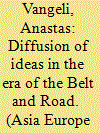

|
|
|
|
|
| Summary/Abstract |
To address part of the puzzle on China’s ideational impact in the era of the Belt and Road Initiative (BRI), the article studies social interaction of Chinese and CEE think tanks by employing the concept of diffusion of ideas. The article proposes a theoretical framework to study diffusion inspired by reflexive social science that focuses on frames, (geoeconomic) imaginaries, and translations. The asymmetrical interaction of think tanks led to aligning the frames of the different actors and producing a context of peaceful and pragmatic cooperation, extension of the geoeconomic imaginaries to include previously unorthodox positions, and translation of policy concepts that are localized in accord with the dispositions of the CEE actors involved. Nevertheless, the China–CEE think tank cooperation, when analyzed in a broader context, has relatively limited impact on societal and policy levels, and is increasingly challenged by actors with greater leverage in the region. What sustain the diffusion of ideas are the potent narratives of imagined futures of prosperity under the New Silk Roads.
|
|
|
|
|
|
|
|
|
|
|
|
|
|
|
|
| 10 |
ID:
164432
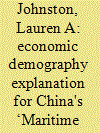

|
|
|
|
|
| Summary/Abstract |
For four decades, China has gradually re-shaped the distribution of global economic activity, underpinned by a low-wage demographic dividend era. For around a decade, however, both demographic and economic structural change, at home and abroad, have incrementally shifted China's comparative advantage away from low-wage industrialisation. In response, China now seeks to become an international investor in these industries under the umbrella of the country's flagship Belt and Road Initiative. That set of changes, in turn, offers a new context of opportunity for developing countries, and especially so for Indian Ocean (IO) countries that are strategically placed along a continental coastline and in the early phase of a process of demographic transition. This explains the economic demography imperative underlying China's twenty-first-century interest to deepen economic ties with IO countries under the umbrella of the 'Maritime Silk Road of the twenty-first century' initiative.
|
|
|
|
|
|
|
|
|
|
|
|
|
|
|
|
| 11 |
ID:
160468
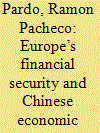

|
|
|
|
|
| Summary/Abstract |
The core of the Belt and Road Initiative (BRI) involves trillions of US$ in investment to increase and improve connectivity between China and different parts of the world. This includes tens of billions of US$ to build or upgrade roads, rail lines, ports, pipelines and other infrastructure to connect China with Europe. With the European continent still feeling the effects of the Global Financial and Eurozone Sovereign Debt crises, this is an opportunity to strengthen its financial security by gaining access to a new source of financing. This new source, however, is linked to Chinese economic statecraft. Thus, cash-starved Europe can tap on the recently launched Silk Road Fund, Maritime Silk Road Fund and other initiatives from the Chinese government. Concurrently, however, political divisions within Europe derived from Chinese investment, as well as normative differences in terms of standards and practices present a challenge to the continent. This article thus analyses the effects of BRI, presented as a tool of Chinese economic statecraft, on Europe’s financial security. It argues that in spite of the latent challenges to said security, the potential benefits have already led many European countries to seek to tap on BRI’s investment as a means to strengthen their financing position.
|
|
|
|
|
|
|
|
|
|
|
|
|
|
|
|
| 12 |
ID:
151264
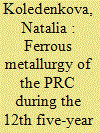

|
|
|
|
|
| Summary/Abstract |
The author examines development problems of the PRC iron and steel industry. In order to create conditions for economic growth and facilitates greater competitiveness of Chinese producers on the world markets, modernization of the metallurgical complex is a priority task.
|
|
|
|
|
|
|
|
|
|
|
|
|
|
|
|
| 13 |
ID:
181838
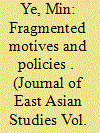

|
|
|
|
|
| Summary/Abstract |
Observers have portrayed the Belt and Road Initiative (BRI) variously, as China's great-power strategy, global infrastructure initiative, or commercial projects. Each characterization has had logical reasoning and evidence to support it. But how? How has one initiative been shown to have such varied motives? This article unpacks the Chinese state and establishes that a “tri-block” structure consisting of political leadership, bureaucracy, and economic arms has accounted for such varied motivations and actors in the BRI in China. In the BRI process, the leadership employed strategic rhetoric, and bureaucracies imposed policy ideas. Yet, more pervasively, the implementers have followed commercial motives in specific projects. BRI's strategic rhetoric and hazardous investment have generated external critiques and anti-China backlash, forcing Beijing to readjust the initiative. However, given the tri-block state structure, Beijing's policy adjustment will not be sufficient. Economic actors’ incentives need to be shifted too.
|
|
|
|
|
|
|
|
|
|
|
|
|
|
|
|
| 14 |
ID:
192981
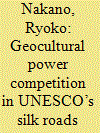

|
|
|
|
|
| Summary/Abstract |
Since Chinese President Xi Jinping announced the Belt and Road Initiative in 2013, China has increasingly engaged in UNESCO’s Silk Roads project. China’s emphasis on its western routes signals its strategic interest in the reconstruction of its historical connections that matches China’s global networking in Eurasia, the Middle East, and Europe. However, whether China will successfully reformulate the international visions of the past, present, and future for its benefit remains an open question. This article focuses on the responses from Japan and South Korea, both of which hold critical positions as the owners of eastern Silk Roads heritage and the funders of UNESCO’s Silk Roads heritage studies and World Heritage nomination assistance. Extending the conceptual framework of memory infrastructure to the study of heritage politics and diplomacy highlights the competitive aspect of a transnational heritage project in shaping and reshaping historical and contemporary geographical landscapes.
|
|
|
|
|
|
|
|
|
|
|
|
|
|
|
|
| 15 |
ID:
179319
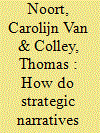

|
|
|
|
|
| Summary/Abstract |
Strategic narratives are increasingly considered important for domestic and international support for foreign policy. However, debate continues about why some strategic narratives successfully shape policy outcomes, while others are rejected. How states construct strategic narratives is well established. We know less about how states appropriate the strategic narratives of others, and the role this plays in policy adoption. Addressing this, we introduce a theoretical framework to trace the relationship between strategic narratives and policy adoption. Its central premise is that a state is more likely to adopt a new policy if it can strategically narrate about it in a way that promises material gain but without undermining its ontological security. We test our framework using states’ responses to China's Belt and Road Initiative (BRI). Examining the Second Belt and Road Forum in 2019, we trace how far China's strategic narratives are appropriated by multiple states – Kazakhstan, Italy, United Kingdom, Netherlands, United States, India, and Mexico. Countries appropriate China's narrative emphasis on connectivity, trade, and prosperity. However, they contest that China's intentions are benign, based on its human rights record, assertive foreign policy, and fears of indebtedness. Finally, we discuss our framework's utility in explaining what makes strategic narratives persuasive in International Relations.
|
|
|
|
|
|
|
|
|
|
|
|
|
|
|
|
| 16 |
ID:
172561
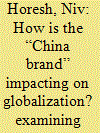

|
|
|
|
|
| Summary/Abstract |
This article is aimed at better understanding China's Overseas Foreign Direct Investment (OFDI) choices through a post-War Japanese historical perspective. It will focus in the main on OFDI as a marker of an advanced stage of the East Asian ‘developmental state’ formula, wherein the ‘China Brand’ takes shape. The transition process from heavy-industry and low-value added goods to frontier-technology manufacturing with global brand recognition will be placed under scrutiny. A Japanese perspective is called for, as much of the theory in the field of international business to do with OFDI and the growth of multinational corporations (MNCs) is currently primarily derived from a Western developed-economy setting, and hence does not seek to offer much in the way of predictive insight about all-important yet middle-income China, as it proceeds towards becoming the largest economy on the planet. The article surveys the historical trajectory of Chinese OFDI, underling its correlation with inbound foreign investment into China; it then offers a comparative view of Japanese OFDI in the pre- and post-War era. It then assesses Chinese brand strength in the electrical appliance, automobile, and IT areas. Finally, it offers a prognosis as to the future direction of Chinese OFDI, and how it might affect the contours of globalization as well as Sino-American rivalries.
|
|
|
|
|
|
|
|
|
|
|
|
|
|
|
|
| 17 |
ID:
184724
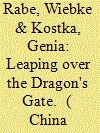

|
|
|
|
|
| Summary/Abstract |
This article traces the process behind the implementation of the “Air Silk Road,” a cargo flight connection between Luxembourg and Zhengzhou, the capital of Henan province. Its origins lie in economic competition between Henan and its neighbouring provinces, dating back a decade before the official announcement of the Air Silk Road in 2017. Provincial and municipal governments in Henan displayed opportunistic risk-taking behaviour in persistently pushing for the development of Zhengzhou's airport economy, but only timing and coincidence allowed the province to gain a foothold in the Belt and Road Initiative (BRI). With findings drawn from fieldwork in China between 2019 and 2020, we contribute to an understanding of the implementation of the BRI, the underlying rationale and the challenges inland provinces face in integrating into the world economy.
|
|
|
|
|
|
|
|
|
|
|
|
|
|
|
|
| 18 |
ID:
179338
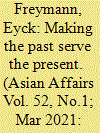

|
|
|
|
|
| Summary/Abstract |
Propaganda is an illuminating and under-studied entry point for assessing the One Belt One Road initiative (OBOR). This essay discusses the ideological and historical claims embedded in three categories of OBOR propaganda: documentary films for domestic audiences, national history textbooks, and short films for English-speaking audiences. Chinese-language propaganda reframe the historical Silk Road as a deliberate, visionary achievement of renowned emperor Han Wudi (r. 141-87 B.C.). The historical narratives work systematically to legitimate Xi's international ambitions by juxtaposing his contributions with those of Han Wudi, including by adjusting factual claims about the ancient Silk Road to make the parallel more obvious. OBOR is thereby cast as a neo-tributary system, in which partner countries enjoy favourable access to China's market and technology-and acknowledge China's preeminent status in return. The historical adventurers Zhang Qian and Zheng He are recast as loyal agents of the emperor in expanding the geographic scope of this system. English-language OBOR propaganda feature a completely different and far more benign narrative about OBOR's historical legacy and contemporary China's ideological motivations. The “Belt and Road Bedtime Stories” cast China as a peace-loving power that respects difference and seeks to protect the existing international order by promoting globalization and free trade. In light of the first two categories of propaganda, I argue that this third narrative is unpersuasive.
|
|
|
|
|
|
|
|
|
|
|
|
|
|
|
|
| 19 |
ID:
172658
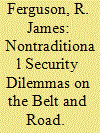

|
|
|
|
|
| Summary/Abstract |
This article explores how, if carefully managed, the Belt and Road Initiative represents an invitation for security cooperation. However, it also risks new forms of military competition and increasing securitization of developmental and environmental issues, a well-known problem for nontraditional security as a conceptual and operational category.
|
|
|
|
|
|
|
|
|
|
|
|
|
|
|
|
| 20 |
ID:
166480
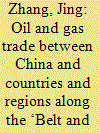

|
|
|
|
|
| Summary/Abstract |
A stable and secure oil supply is essential to achieve sustainable development in China. The country mostly imports oil and gas from countries along the ‘Belt and Road’, which are major destination countries for the export of Chinese-manufactured products. Strengthening trade with these countries is essential to not only secure China's oil and gas supply but also promote development in the area. Based on the global commodity chain and value chain concepts, this paper analyses the status and prospects of the oil and gas trade between countries, considering all trade relations, which avoids the one-sidedness of oil and gas trade analysis based on the demand–supply relationship. We find that the general trade relationship between China and the countries along the Belt and Road is closely related to their oil and gas trade. Oil and gas resources are the main commodities exported to China by countries and regions having close trade relationships with it. Chinese policies should thus focus on developing the oil and gas trade with central Asia and Mongolia and improving the country's competitive advantage in traditional manufacturing exports, which, in turn, can enhance its position in international oil and gas trade.
|
|
|
|
|
|
|
|
|
|
|
|
|
|
|
|
|
|
|
|
|